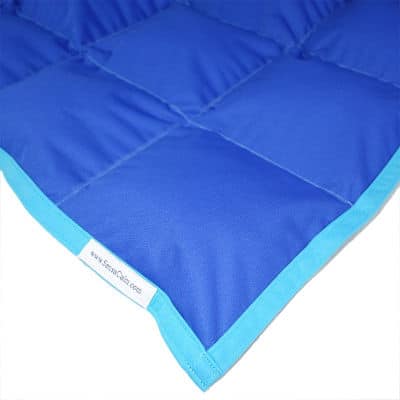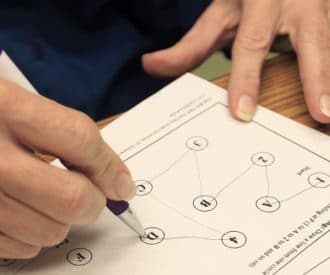Weighted blankets are emerging as a simple yet powerful tool to ease two of dementia’s most challenging symptoms – sleep disturbances and anxiety. By delivering gentle, full-body pressure (similar to a comforting hug), these therapeutic blankets may help regulate the nervous system, reduce sundowning agitation, and promote more restful nights.
While not a cure, many caregivers report dramatic improvements when their loved ones use properly weighted blankets. Here’s what families should know about choosing and safely using this drug-free calming aid.

Weighted Blankets for Dementia Promote Calmness
Alzheimer’s disease and dementia often cause older adults to feel agitated, anxious, or have disturbed sleep.
A weighted blanket or lap pad is a simple, non-drug option used day or night.
They promote deep sleep, reduce anxiety, calm nerves, and provide comfort.
We explain how weighted blankets and lap pads help seniors with dementia, suggest weighted blankets to buy, and share DIY tutorials for making your own.
How Do Weighted Blankets for Dementia Work?
Weighted blankets for dementia may sound silly, but they’ve been scientifically proven to relieve anxiety.
The heaviness of the blanket provides something called deep pressure therapy.
When the body feels the gentle pressure, it produces serotonin. That improves mood and promotes calm.
Studies show that weighted blankets are a safe and effective therapy for decreasing anxiety, reducing chronic pain, improving sleep in dementia, and improving sleep and well-being among nursing home residents.

What many weighted blankets look like
Use a Weighted Blanket Day or Night
A weighted blanket for deep pressure therapy can be used anytime, day or night.
If your older adult wakes frequently during the night, consider a weighted blanket that covers their body. The blanket will help them relax and improve sleep quality.
If your older adult is anxious or agitated during the day, a weighted lap pad can provide the same calming and soothing effect in a more convenient, compact size.
Some Health Issues May Make Weighted Blankets Unsafe
Since many older adults have severe medical conditions, it's important to ask their doctor if a weighted blanket is safe for them to use.
People with respiratory, circulatory, or temperature regulation problems may not be able to use a weighted blanket or lap pad safely.
They may also not be safe if an older adult is in recovery from surgery.
How Heavy Should a Weighted Blanket Be?
The weight of the blanket depends on an older adult’s weight and physical condition.
The usual guideline is that a blanket should be about 5 – 10% of your older adult’s body weight.
Depending on size, many adults will be comfortable with a blanket weighing 10 to 30 pounds.
If they’re frail, you may want to be extra cautious and use a lower weight.
And since lap pads cover a smaller area, the typical weight is about 2 to 5 pounds.
Where to Buy a Weighted Blanket or Lap Pad
Note: Weighted blankets are sized to fit the user, not the bed. Get size guidelines here.
1. Affordable weighted blanket options
- $36 5lb Weighted Blanket – Cotton and Minky Dots – 5 lbs, 36 x 48 inches
- $42 Hug Bud Weighted Blanket – 12 lbs, 48 x 72 inches
- $25 (plus 10% off coupon) ZZZhen Weighted Blanket – 15 lbs, 48 x 72 inches
- $30 (plus 5% off coupon) YnM Weighted Blanket – 15 lbs, 48 x 72 inches
- $37 (plus $10 off coupon) Weighted Idea Cooling Weighted Blanket – 15 lbs, 48 x 72 inches
- $42 (plus $4 off coupon) Hypnoser Adult Weighted Blanket – 20 lbs, 60 x 80 inches
- $80 Weighted Blanket – 25 lbs, 60 x 80 inches
2. $25 – 500 SensaCalm weighted blankets and lap pads
- Blankets, lap pads, shoulder wraps, and other weighted products
- Weights from 1.5 – 40 pounds
- Prices from $25 – 500, based on size, weight, and fabric
- Choose from a variety of fabric colors, textures, and patterns
- Browse the SensaCalm website
3. $38 – 296 Sommerfly weighted blankets
- Blankets, lap pads, vests, shoulder wraps, and other weighted products
- Blankets have a curved cut-out at the top for the neck
- Weights from 1 – 25 pounds
- Prices from $38 – 296, based on size and weight
- Customization is available on the Sommerfly website
- This waterproof, wipe-clean weighted blanket might be helpful for someone living with incontinence
Make Your Own DIY Weighted Blanket or Lap Pad
You can easily make your weighted lap pad or blanket if you enjoy crafts or sewing. We’ve rounded up 3 helpful free online tutorials.
Use the tutorials as a guideline and customize the size, weight, filler material, and fabric to suit your older adult’s needs.
The most important thing to remember is to divide the filler weight evenly across the blanket.
If you use rice or beans instead of plastic pellets for the filling, make sure the container has a removable outer cover so it can be washed.
Using plastic pellets as filler makes the whole blanket washable, but the pellets are more expensive than rice or beans.
Note: Weighted blankets are sized to fit the user, not the bed. See size guidelines here.
1. No-sew weighted lap pad
This is a good tutorial for an easy, no-sew weighted lap pad with the added bonus of a sequined cover providing additional sensory stimulation.
You could easily substitute a plain fabric pillow cover or attach fidget items to keep restless hands occupied. See the tutorial
2. No-sew weighted lap pad or blanket
This tutorial shows how to make a no-sew weighted lap pad or blanket. The size is flexible, make it as large or small as you like.
The tutorial uses rice to fill the bags, but other filler materials like beans or plastic pellets could be used. See the tutorial part 1 and part 2
3. Simple weighted lap pad or blanket (sewing required)
This video tutorial walks through each step of sewing a weighted lap pad or blanket in whatever size will work for your older adult.
We especially like that the video shares tips to help you avoid problems like broken needles, how to keep the heavy blanket supported as you sew, and more.
This woman made her blanket with non-weighted pockets down the sides and with stuffing.
Feel free to customize your blanket to your older adult’s preference. You could follow her directions, not use stuffing for a flatter blanket, or add weight to every pocket. See the tutorial
Recommended for you:
- 5 Tips to Improve Sleep in Dementia
- 7 Ways to Reduce Dementia Sundowning Symptoms
- Solve Challenging Alzheimer’s Behaviors with Expert Communication Tips
This article reflects prices at publication, but prices and availability may change. This article contains affiliate links. For more information, see How We Make Money.
About the Author

Connie Chow
Connie was a hands-on caregiver for her grandmother for 20 years. (Grandma made it to 101 years old!) She knows how challenging, overwhelming, and all-consuming caring for an older adult can be. She also knows how important support is — especially in the form of practical solutions, valuable resources, and self-care tips.





I take care of my mom, 105, & I will investigate this. However, I have R.A. and found that sometimes during a flare-up my regular blankets are so heavy I can’t get out of bed by myself. No matter how hard I try.
We hope a weighted blanket will work well for your mom. They’re not always suitable for every person, depending on their specific health conditions.
I feel, being a senior myself, that this blanket may help my sleeping situation. I would like to thank you for the concern and research of what is necessary for the comfort of our elderly.
Sincerely,
I’m so glad this article is helpful! I hope a weighted blanket does help you sleep better.
From my work, I know that children on the FASD spectrum often are calmed by using weighted blankets, or pressure vests when they are up.
Is this the same reason in both cases? I have seen how effective the vests are – would an adult sized pressure vest be useful in a dementia situation?
Yes, I think a weighted vest would be a good option too! For a quick DIY option, adding pouches of weighted beads into a vest with multiple pockets would work. Weighted vests for adults are also available for purchase — some are made for athletic use, but would probably work just fine for someone with dementia.
Do you have a monthly news letter/magazine? I love the tips!!
So glad our suggestions are helpful! We have a free daily email newsletter that keeps you up to date with the latest practical tips and useful resources. Sign up using any of the sign up modules on our site: pop-ups on the page, at the very top of the page, in the right sidebar, and at the bottom of the page.